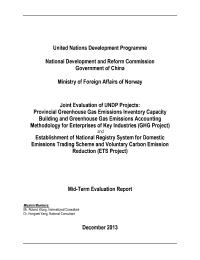
Combined mid-term evaluation of two projects: Design and Establish National Voluntary Emission Reduction Project Registry System and National Emissions Trading Scheme Registry System and Provincial Greenhouse Gas Emissions Inventory Capacity Building and Greenhouse gas Emissions Accounting Methodologies for Enterprises of Key Industries Project
Completedon 2 Dec, 2012
Evaluation Plan
Planned End Date
Jan 2014
Evaluation Type
Project
Management Response
Yes
Evaluation Budget
$40,000
Evaluation Title
Combined mid-term evaluation of two projects: Design and Establish National Voluntary Emission Reduction Project Registry System and National Emissions Trading Scheme Registry System and Provincial Greenhouse Gas Emissions Inventory Capacity Building and Greenhouse gas Emissions Accounting Methodologies for Enterprises of Key Industries Project
Atlas Project Number
00080582, 00080583
Plan Period
Status
Completed
Type
Project
Plan Date
1 Jan, 2014
Completion Date
2 Dec, 2012
Budget
$40,000
Expenditure
$0
Management Response
Yes
Quality Assessment
No
Joint Programme
No
Joint Evaluation
No
GEF Evaluation
Yes
Expand
Countries
China
Atlas Project Number
00080582, 00080583
Plan Period
Status
Completed
Type
Project
Management Response
Yes
Plan Date
1 Jan, 2014
Quality Assessment
No
Completion Date
2 Dec, 2012
Joint Programme
No
Joint Evaluation
No
Budget
$40,000
GEF Evaluation
Yes
Expand
Expenditure
$0
Countries
China
Development plans and programmes integrate environmentally sustainable solutions in a manner that promotes poverty reduction, MDG achievement and low-emission climate-resilient development
National and local governments and communities have the capacities to adapt to climate change and make inclusive and sustainable environment & energy decisions benefitting in particular under-served populations
1: Environment & Sustainable Development


